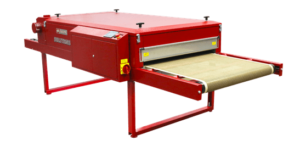

Революция в индустрии трафаретной печати благодаря передовым технологиям и качественному обслуживанию
Anatol Equipment Manufacturing Co.
1429 S Shields Dr
Waukegan, IL 60085


Революция в индустрии трафаретной печати благодаря передовым технологиям и качественному обслуживанию
Anatol Equipment Manufacturing Co.
1429 S Shields Dr
Waukegan, IL 60085

In the past it was relatively easy to set your dryer to cure your ink on the apparel being printed; most textile printing was being done on cotton or 50/50 apparel with plastisol ink. Nylon fabric did require some special attention, as did some specialty inks. Curing plastisol ink was a matter of placing your garment on your dryer’s conveyor belt with the proper amount of heat and setting the belt speed for the correct length of time. As a result, the dryer settings were not changed very often and, given a consistent and reliable dryer, the plastisol was successfully cured and bonded to the apparel. Properly cured plastisol ink had a heavy hand but lasted seemingly forever.
Fast forward in time and the apparel lineup began to grow, including 100% polyester with a whole host of bleed issues, as well as elastic fibers such as lycra and spandex. Suddenly there were numerous issues that needed to be addressed to ensure a proper cure. Most recently, tri-blends (polyester/rayon and cotton) have populated the market with their own unique set of curing issues. Even bamboo has been introduced and used with polyester and cotton. Compared to cotton, these fabrics have lower scorching temperatures, are more susceptible to dye migration and bleeding, and are more likely to experience shrinking issues — so it’s best to cure them at the lowest temperatures possible.
Fabrics aren’t the only screen printing supplies that have changed. To make matters even more interesting, with the advancement in ink technology (likely spurred by the fashion market’s demand for a softer hand feel) water-based inks became popular. However, they cure quite differently than plastisol. In order to properly cure water-based inks, two things have to occur. First the ink must be dried. Water is only the base (or solvent) that carries the colored pigment. The color will not fully release into the printed apparel if it’s wet. Once completely dried, the colored pigment will fuse to the cloth garment. While there will often be some fading after washing the print, it will be less if the garment has been properly cured. Water-based inks require additional time in the dryer, usually at least twice as long as plastisol. A conveyor dryer is most effective at curing water-based ink when accompanied by a dynamic air flow that maximizes air circulation, coupled with air replacement in the heat chamber.
Every combination of fabric and ink will require a different procedure to properly cure; your ink manufacturer should be able to provide suggestions, but there’s no substitute for thorough testing to make sure you get good results. For a more detailed discussion of tests you can perform to check the quality of your cure, check out this blog post. After you’ve developed and tested your procedures, it’s helpful to have a conveyor dryer that will let you record them.

Anatol conveyor dryers like the Solutions allow you to
save and recall a wide variety of settings, saving you time.
Two of the most important parameters your dryer should be able to save and recall are belt speed (usually calculated in feet per minute and used to determine dwell time) and temperature. If your dryer can save and recall job parameters like these, it will assist you greatly in reducing curing issues and keeping your customers pleased with your performance. Having repeatable procedures will also save you time — if you know how you cured a job successfully the first time, you won’t have to struggle to cure it again if the order is repeated.
Please note this caveat — even with accurate programmable settings, you still have to make sure you pay attention to quality control and do occasional testing to ensure proper curing. If something runs amok (you experience a power lapse, dryer malfunction, etc.), it’s to everyone’s benefit to catch the problem as early as possible. By combining careful attention, detailed procedures and a reliable, accurate conveyor dryer, you can cure your garments perfectly no matter what type of fabric or ink you’re using. A properly cured garment will last long, look great and keep your customers coming back for more.
Looking for more tips on how to handle challenging inks and fabrics? Check out these blog posts:
Overcoming the Challenges of Screen Printing Athletic Apparel
Curing Water-Based Ink the Right Way
Our Six Best Tips for Screen Printing on Fleece
Or check out our free eBook: How to Choose the Right Conveyor Dryer
Your message was successfully sent!